
Xuanzang, born Chen Hui / Chen Yi, also known by his Sanskrit Dharma name Mokṣadeva, was a 7th-century Chinese Buddhist monk, scholar, traveler, and translator. He is known for the epoch-making contributions to Chinese Buddhism, the travelogue of his journey to India in 629–645 CE, his efforts to bring over 657 Indian texts to China, and his translations of some of these texts. He was only able to translate 75 distinct sections of a total of 1335 chapters, but his translations included some of the most important Mahayana scriptures.

The Greco-Buddhist art or Gandhara art is the artistic manifestation of Greco-Buddhism, a cultural syncretism between Ancient Greek art and Buddhism. It had mainly evolved in the ancient region of Gandhara, located in the northwestern fringe of the Indian subcontinent.
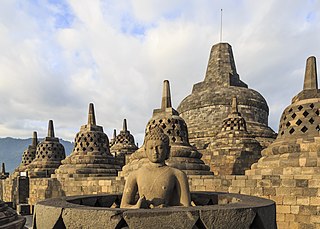
Buddhist religious architecture developed in the Indian subcontinent. Three types of structures are associated with the religious architecture of early Buddhism: monasteries (viharas), places to venerate relics (stupas), and shrines or prayer halls, which later came to be called temples in some places.

Shravasti ; Pali: 𑀲𑀸𑀯𑀢𑁆𑀣𑀻, romanized: Sāvatthī) is a town in Shravasti district in Indian state of Uttar Pradesh. It was the capital of the ancient Indian kingdom of Kosala and the place where the Buddha lived most after his enlightenment. It is near the Rapti river in the northeastern part of Uttar Pradesh India, close to the Nepalese border.

Buddhist art is visual art produced in the context of Buddhism. It includes depictions of Gautama Buddha and other Buddhas and bodhisattvas, notable Buddhist figures both historical and mythical, narrative scenes from their lives, mandalas, and physical objects associated with Buddhist practice, such as vajras, bells, stupas and Buddhist temple architecture. Buddhist art originated in the north of the Indian subcontinent, in modern India, Pakistan and Afghanistan, with the earliest survivals dating from a few centuries after the historical life of Siddhartha Gautama from the 6th to 5th century BCE.
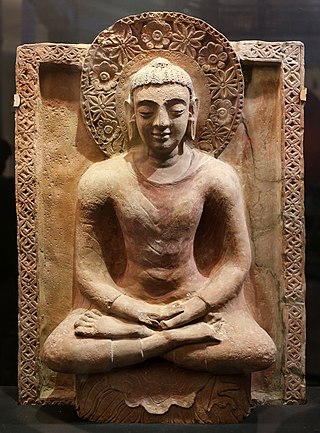
Kahu-Jo-Darro, also known as Mirpur Khas stupa, is an ancient Buddhist stupa found at the Mirpurkhas archaeological site in Sindh, Pakistan. The site is spread over 30 acres (120,000 m2). Excavations completed before 1910 revealed this large brick-based stupa and numerous terracotta reliefs now displayed in major world museums. The Mirpur Khas site is notable because historic Indian and Arab coins were found during its excavation. This has led scholars such as Derryl MacLean to suggest that Buddhism was thriving in Sindh region around the 10th-century and became extinct in these parts of the west and northwest South Asia after the Islamic conquest.

Ujjayanta Palace is the state museum of the Indian state of Tripura and former royal palace of the princely state of Tripura. It was built by Maharaja Radha Kishore Manikya in 1901. It housed the State Legislative Assembly up to 2011. The palace primarily showcases the lifestyle, arts, culture, tradition and crafts of communities residing in northeast India, along with many stone sculptures of the Manikya dynasty.
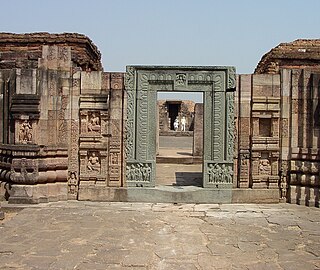
Ratnagiri is the site of a ruined mahavihara, once the major Buddhist monastery in modern Odisha, India. It is located on a hill in between the Brahmani and Birupa rivers in Jajpur district. It is close to other Buddhist sites in the area, including Lalitagiri and Udayagiri, and 100 km (62 mi) from the state capital Bhubaneswar and 70km from the former state capital Cuttack.
Kanganahalli, situated about 3 km from Sannati, is an important Buddhist site where an ancient Mahastupa was built. It is on the left bank of the Bhima river in Chitapur taluk, Kalaburagi district in Karnataka, India. Nalwar is the nearest Railway station about 19 km from Sannati. The Buddhist site about 2.5 km from Chandrala Parameshwari temple of Sannati.

Prambanan Temple Compounds is the World Heritage designation of a group of Hindu temple compounds that lie on the border between Yogyakarta and Central Java, Indonesia. It comprises Prambanan, Lumbung, Bubrah and Sewu temple compounds, all are located within Prambanan Archaeological Park.
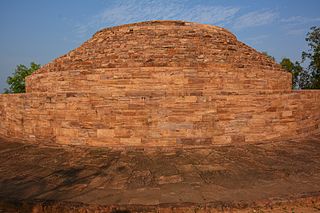
Lalitagiri is a major Buddhist complex in the Indian state of Odisha. The complex is home to stupas, 'esoteric' Buddha images, and monasteries (viharas), which is the oldest site in the region. Significant finds at this complex include Buddha's relics. Tantric Buddhism was practiced at this site.
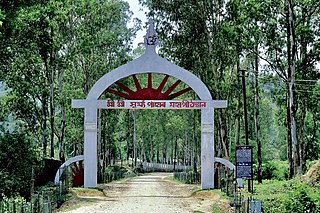
Sri Surya Pahar is located about 12 km southeast of Goalpara, about 132 km northwest of Guwahati, is a significant but relatively unknown archaeological site in Assam, India. Goalpara is the nearest city from the site. The site is a hilly terrain where several rock-cut Shivalingas, votive stupas and the deities of Hindu, Buddhist and Jain pantheon are scattered in an area of about one km. The site is centered on the hills (Pahar) of Sri Surya which is profusely filled up with Shiva Lingas (Lingam). People have found 99999 Shiva Lingas were engraved here by Vyasa in order to build up a second Kashi and once it was one of the holiest pilgrimage sites in the region. There is no historical evidence exactly how many Lingams once dotted in these hills, but still there are hundreds of them, from tiny to large in size, scattered everywhere at the foot of the hill and covering the extensive area after centuries of neglect and pilferage. The exact figure of the Lingas in the hill is yet to be counted scientifically.
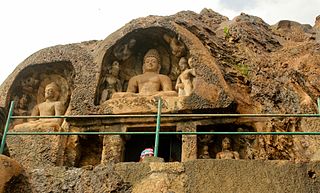
Bojjannakonda and Lingalakonda are two Buddhism rock-cut caves on adjacent hillocks, situated near a village called Sankaram, Anakapalle of ancient Kalinga. in the Indian state of Andhra Pradesh. The sites are believed to date between 4th and 9th Century A.D, when Buddhism is the majority religion of Sankaram. The original name of Bojjannakonda is Buddina Konda.

Buddhism amongst the Tamils was historically found in the Tamilakam region of India and Sri Lanka.

Kolvi Caves, or Kholvi Caves, are located at Kolvi village of Jhalawar district in the state of Rajasthan, India. They are carved out in laterite rock hill. This Buddhist site has stupas, chaityas containing figures of Buddha. An architectural style shows dominance of Mahyana sect in this region in the 8th-9th century CE. Around 50 caves have been found here. The caves has statues of Buddha in the meditation and standing position. The stupas and colossal statues of Buddha are archaeologically significant. Around Kolvi village similar caves have been discovered which proves existence of prosperous Buddhist civilization in the region. Though the evidence of Kolvi is very important to register presence of Buddhism in Rajasthan, the caves are very similar to the Bagh Caves and show cultural affinity with a region that is geaographically close.

The Dhamnar Caves are caves located in the village of Dhamnar, located in Mandsaur district in the state of Madhya Pradesh, India. This rock cut site consists of 51 caves, stupas, Chaityas, passages, and compact dwellings, carved in the 7th century CE. The site includes large statues of Gautama Buddha in sitting and Nirvana mudra.

Chandavaram Buddhist site is an ancient Indian Buddhist site in Chandavaram village in Prakasam district in the Indian state of Andhra Pradesh. Situated on the bank of Gundlakamma River, the site is 10 kilometres (6.2 mi) northwest of Donakonda railway station. The Chandavaram Buddhist site was built between the 2nd century BCE and the 2nd century CE during the Satavahana dynasty and was discovered by Veluri Venkata Krishna Sastry in 1964.

Devnimori, or Devni Mori, is a Buddhist archaeological site in northern Gujarat, about 2 kilometres (1.2 mi) from the city of Shamlaji, in the Aravalli District of northern Gujarat, India. The site is variously dated to the 3rd century or 4th century CE, or circa 400 CE. Its location was associated with trade routes and caravans in the area of Gujarat. Site excavations have yielded Buddhist artifacts dated prior to 8th-century in the lowest layer, mixed Buddhist and Hindu artwork from the Gurjara-Pratihara period in the middle, topped by Muslim glazed ware attributed to the 14th century. The site was excavated between 1960 and 1963. The site became flooded by the Meswo reservoir, a project started in 1959 and completed between 1971–1972 over the nearby Meshwo River.

Gandhāran Buddhism refers to the Buddhist culture of ancient Gandhāra which was a major center of Buddhism in the northwestern Indian subcontinent from the 3rd century BCE to approximately 1200 CE. Ancient Gandhāra corresponds to modern day north Pakistan, mainly the Peshawar valley and Potohar plateau as well as Afghanistan's Jalalabad. The region has yielded the Gandhāran Buddhist texts written in Gāndhārī Prakrit the oldest Buddhist manuscripts yet discovered. Gandhāra was also home to a unique Buddhist artistic and architectural culture which blended elements from Indian, Hellenistic, Roman and Parthian art. Buddhist Gandhāra was also influential as the gateway through which Buddhism spread to Central Asia and China.

The Buddha Preaching his First Sermon is a stone sculpture of the 5th-century CE showing Gautama Buddha in the "teaching posture" or dharmachakra pravartana mudrā. The relief is 5' 3" tall, and was excavated at Sarnath, India by F. O. Oertel during the 1904–1905 excavation season of the Archaeological Survey of India (ASI); it was found in an area to the south of the Dhamek Stupa.


















